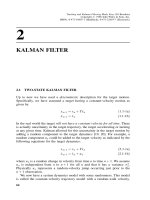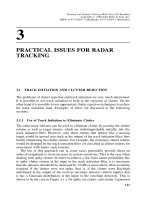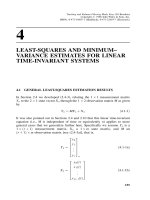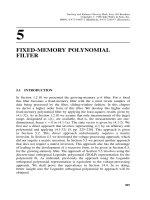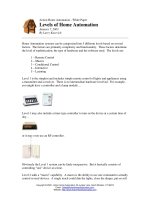Home made mini glassworking lathe
Bạn đang xem bản rút gọn của tài liệu. Xem và tải ngay bản đầy đủ của tài liệu tại đây (799.17 KB, 8 trang )
Homemade Mini Glassworking Lathe
Homemade Mini Glassworking Lathe
(Design notes appear at the bottom of this page.)
(1 de 8)24/03/2005 2:47:40
Homemade Mini Glassworking Lathe
(2 de 8)24/03/2005 2:47:40
Homemade Mini Glassworking Lathe
(3 de 8)24/03/2005 2:47:40
Homemade Mini Glassworking Lathe
(4 de 8)24/03/2005 2:47:40
Homemade Mini Glassworking Lathe
Design Notes
A glassworking lathe is a specialized lathe for manipulating glass.
(5 de 8)24/03/2005 2:47:40
A torch is
Homemade Mini Glassworking Lathe
used instead of a cutting tool for shaping the glass. The glass, usually in the
form of a tube, is held by two rotating chucks. The chucks face each other and
rotate in sync. One chuck is mounted on a stationary headstock while the other
is mounted on a moving one. The chucks and headstock shafts are hollow so that
the glass and/or a blowhose may be passed through them.
The glassworking lathe described here is designed around TAIG metalworking lathe
kit components.
The design goals were:
1) Low cost.
2) Simplicity.
3) Optional headstock de-synchronization.
This site describes but one approach to building a glassworking lathe
and is not intended to be a "how-to". Your metalworking skills,
electronics experience, and pocketbook may dictate an entirely different
design. Please note that there are no plans or kits for this lathe.
Two headstocks and two scroll chucks were ordered instead of the normal
one of each, and no tailstock was purchased as that was replaced by the
second, moving headstock.
The TAIG 3-jaw scroll chucks were essential to the design. At only
$44/chuck there was no way I could make anything that good and that cheap
even though I have my own full-size metalworking mill and lathe.
The jaws are easily replaceable so one could make new ones out of more
appropriate materials (lower thermal conductivity, etc.) but so far I've
just put a bit of hi temp tape on each aluminum jaw and that has worked
just fine.
The headstocks can pass small diameter (~0.344") tubing through
their centers, the chucks can pass about twice that.
This makes connection of the blowhose easy via a stopper in the end of
the glass tube, or, smaller diameters of glass tubing can just be passed
through the chuck/headstock to the blowhose & blowhose swivel outside of
the lathe.
In the present setup, the lathe will turn something 7-inches in diameter
with 12 1/2 inches between the faces of the 3-jaw chucks. The lathe
components are mounted on a length of heavy aluminum channel.
Two 130 oz-in surplus steppers are used - one for each headstock.
This _greatly_ simplifies the mechanics allowing for synchronization &
easily variable speed. The steppers were only $9.95 each from Herbach &
Rademan. I was surprised that the 130 oz-in steppers barely have enough
torque for the job, and they turned so slowly that I had to "gear" the
setup as shown to get a good range of speed. The final setup with timing
belt drive achieves a speed range of 6 RPM to 240 RPM (half-stepping the
steppers.) This is on par with what "real" Litton glassblowing do.
The stepper driver was built around two Allegro UCN5804 stepper driver chips.
International Rectifier IRLZ44N logic-level-drive HEXFETS power the stepper
(6 de 8)24/03/2005 2:47:40
Homemade Mini Glassworking Lathe
coils. The two separate stepper chips (<$4 each) will provide the capability
in the future of doing any CNC trick twisting of the work. The UCN5804 has
very limited drive, so the 55V 47A(!) HEXFETS should be able to handle any
stepper imaginable.
I first made O-ring drive pulleys - but not quite well enough. There was a
slight difference in diameters between the pulleys on each stepper which caused
loss of synchronization. There was enough slip in the belts and in the grip of
the chucks on the tubing that it wasn't an immediate problem. Timing belt drive
is a better solution but I couldn't find any suppliers of these (or gears) that
took orders over the 'net so I got impatient and machined the pulleys and made
O-ring drive belts. (No - Berg, Stock Drive, etc., are still in the Dark Ages
with no on-line pricing & ordering!)
I next installed a timing belt drive
system using pulleys from McMaster-Carr (small selection - but at least their
on-line ordering works.) But, these were steel and presented too much mass for
the steppers to reliably start. I finally replaced the larger steel timing belt
pulleys with plastic ones - that fixed the problem. The two chucks turn
perfectly in sync. (BTW: I'd just as soon as avoid a chain drive - ever get
something caught in a chain?)
I believe that some of the "real" glassworking lathes use a single motor
driving a long splined shaft with moving return guides to sync their chucks.
This is great, but is also _very_ expensive. One splined shaft and one return
guide costs as much as I spent on my entire glassworking lathe! ($400) Plus,
the splined shaft design requires a _lot_ more mechanics and doesn't allow
de-synchronization when you want it without even more mechanics.
An alternative to a splined shaft - just use a simple square shaft. Square
stock is cheap and is available in long lengths. The ends could be turned round
for the needed end bearings. The follower could be easily made from a block of
Delrin with a square hold in it (make a square hole by milling a notch in a
block, then close off the opening ("C") with a bar of material to end up with a
square hole.) Still - this is more work & mechanics, and the headstocks can't
be de- synchronized if one wants.
An idea for another inexpensive approach to the headstocks and chucks - lathe
collet spin index fixtures. Did you know that Litton sells redwood collets
for their glassworking lathes?
The TAIG lathe components were purchased from Nicholas Carter:
Suppliers of professional glassworking lathes:
Litton Engineering Glassworking Lathes
Heathway Glassworking Lathes
Warner Lathes
Arnold Glassworking Lathes
Wale Apparatus
(7 de 8)24/03/2005 2:47:40
Homemade Mini Glassworking Lathe
1) My Peltier Device Information Directory
2) My Used High Tech Equipment Dealer Directory (the biggest on the 'net)
3) My 97' long fused glass-on-brick project
(c) 2000-2003
Steve J. Noll
(Please note that there are no plans or kits for this lathe.)
Okay, here's a schematic - but, you're on your own!
(8 de 8)24/03/2005 2:47:40





